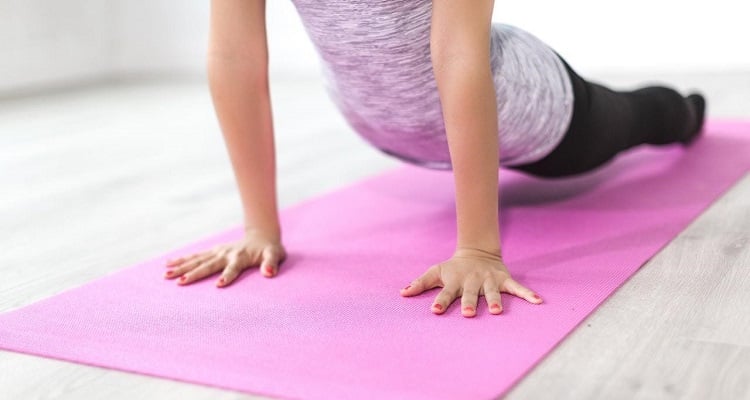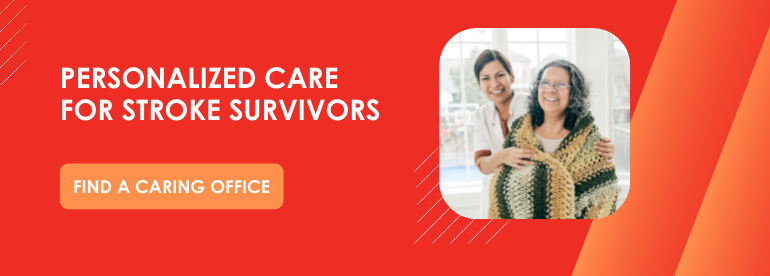Thanks to developments in technology and medical treatment, stroke survival rates are up along with the possibility of recovery. However, coming back from a stroke is by no means easy; it takes a large amount of effort from a stroke survivor and lots of support from their medical team and loved ones.
While some seniors may still struggle from long-term effects from a stroke, many will be able to regain movements or relearn muscle control to help them remain as independent as possible. To help seniors recover, we’ve put together some common exercises designed to help seniors regain strength and control after a stroke.
When considering these exercises, you need to take a senior’s abilities into consideration. Some will require a lot of assistance and others may be able to perform exercises on their own. When you must assist a senior, these exercises are referred to as passive exercises. When they can perform them on their own, they are considered active exercises. We will review examples of both types of exercises for stroke survivors.
Passive Exercises
Passive exercises involve the assistance of another individual. While a senior isn’t performing the exercise on their own, these exercises can still help them retrain muscles and maintain range of motion.
Upper Body
Let’s start with the arms, including the shoulder, elbow, wrist, and hand. Stroke survivors may need help moving their arms to their full extent. Range of motion exercises can help them stretch their muscles.
- Shoulder: Support the arm by placing one hand at the senior’s wrist and the other between the shoulder and elbow. Help them lift their arm up. Then, help them raise it to the side. Try to keep the elbow bent softly and make sure the senior’s thumb is facing up.
- Elbow: Help the senior move the elbow joint up and down. Do not push the joint further than it can go. Then, move the forearm so that the senior’s wrist faces upward and then downward.
- Wrist: Hold the wrist with one hand and then use the other to help guide the hand upwards and downwards, with the palm flat. This helps move the hinge joint of the wrist.
- Hand: Lift each finger up to stretch the muscles. Do not push the fingers further than they are able to move. Then, bend each joint in the fingers.
Over time, seniors may be able to perform parts of this routine on their own. Generally, strength returns in the shoulder and then muscle groups improve further down the arm. As seniors develop more strength, assist them as needed and encourage them to complete exercises independently.
For more passive arm exercises, check out this video from physical therapists who work with stroke survivors.
Lower Body
Now, let’s review some exercises that you can perform with seniors to benefit their lower body, including the hip, knee, ankle, and feet.
- Hip: Support a senior’s leg by placing your hand underneath the thigh and the other hand grasping the senior’s foot. Bend the knee towards the chest and then release to move the hip joint. With your hands in the same position, you can also straighten the leg and then move it out away from the body and then across the body to achieve full range of motion in the hip.
- Knee: Place one hand under the knee to support it, and use your other hand to hold the senior’s foot. Slowly bring the foot in to bend the knee joint, and then straighten. You can also keep the knee straight and lift the leg up to help stretch the hamstring.
- Ankle: To stretch the ankle, cup your hand under the senior’s heel and press the rest of the foot against your forearm. Then push on the ball of the foot with your forearm. You can also support the ankle with one hand and push down on the top of the foot to stretch the front muscles of the leg. From this position, you can also move the senior’s foot in a circular motion.
- Feet: With your hand, press on a senior’s toes above the ball of the foot to flex the toes. Then, press downward on the toes to point them.
To get more passive exercises for the lower body, check out this video from the Joe Martin ALS Foundation.
Active Exercises
For seniors who have some strength and control over their muscles, work with them on these active exercises. They involve the senior doing most of the work, but a family member or professional caregiver can be present to support them and track progress.
Upper Body
The following exercises are designed for seniors with a good range of motion and who have some strength and control in their shoulder, elbow, wrist, and fingers. The goal of these exercises is to help slowly build muscles and to reestablish connections with the brain.
- Shoulder: Seniors can sit at a table with a water bottle or cup in front of them. With their arm flat against the table, they can push the object away from them and then slowly bring it back. Do not elevate the shoulder. This exercise practices a forward reaching motion. Then, try moving the water bottle back and forth across the table, using the arm to push the bottle slowly.
- Elbow: Stroke survivors can also practice their bicep curls. They should start without any weight in the beginning, but can slowly add some weight as they are able. Start with the elbow at a 90-degree angle. Then, just curl the arm up and release it back down.
- Wrist: Seniors can also practice wrist curls on their own as well. Then, try moving the wrist to the left and the right while the palm remains down. It may be easiest to keep the hand on a flat surface, like a table, to perform this wrist side movement.
- Fingers: Seniors can practice curling their fingers around a rounded object, like a stress ball or a water bottle. Curl the fingers and then release. Another great exercise for the fingers is to try spinning a pen or pencil on a table. Isolate the fingers and try to keep the rest of the arm still.
For more active stroke arm exercises, check out this video from Rehab HQ.
Lower Body
The next set of active exercises are designed to help develop muscles and coordination in the lower body, including the hip, knee, ankle, and feet.
- Hip: Seniors can sit in a chair and lift their leg up toward the chest. Use your arm’s if your leg isn’t quite strong enough on its own. For more of a challenge, you can practice a marching position in your chair, alternating the lifting leg back and forth, and put your hand on your leg for added resistance.
- Knee: While seated, a senior can straighten their knee so their leg is straight in front of them. Then, lower the leg and repeat.
- Ankle: Seniors can roll their ankles in circles, going clockwise and counter-clockwise. This exercise is best performed while seated.
- Feet: Stroke survivors can also practice pointing and flexing their toes. They may want to sit in a reclined position with their feet up.
For additional ideas on active leg exercises, watch this video from Flint Rehab.
These are just a few of the many exercises that can help stroke survivors regain their independence. Seniors may have specific exercises prescribed by their physical therapist or another health professional. Of course, these should always take precedence over the general exercises we’ve outlined here.
For more information on strokes, refer to our free stroke-related resources!


